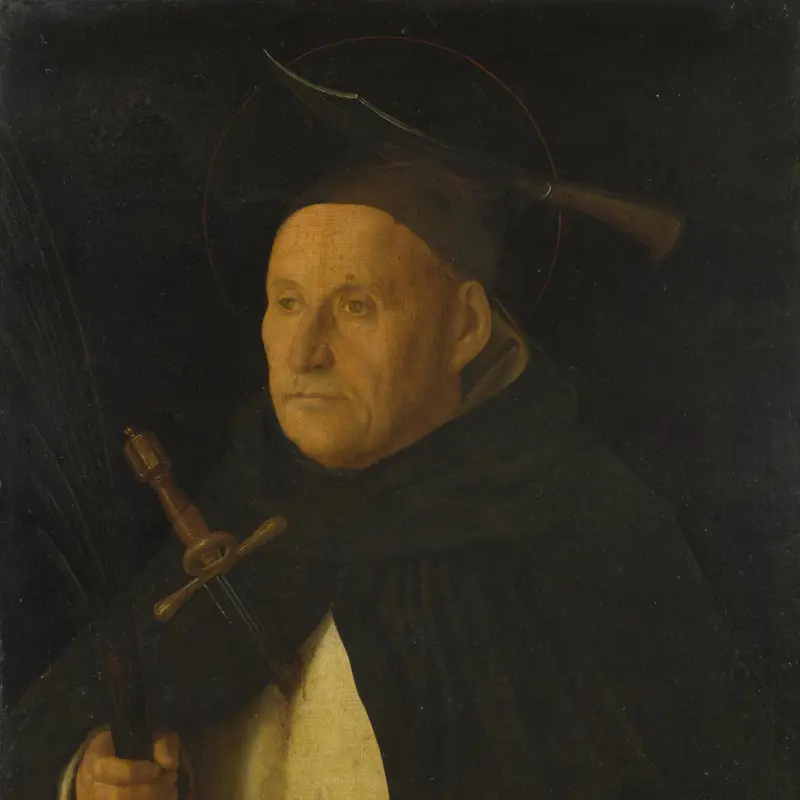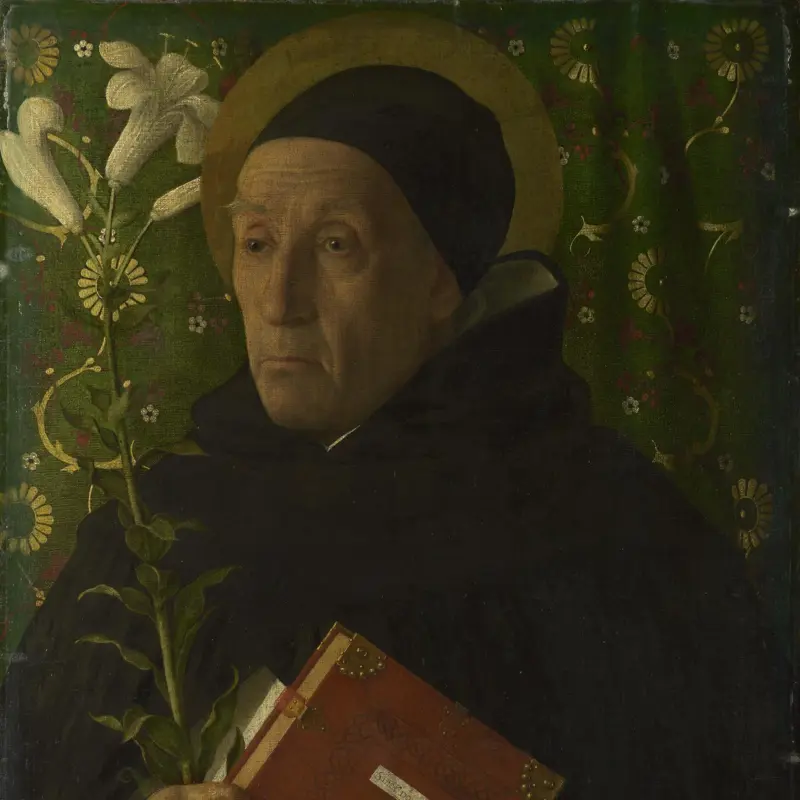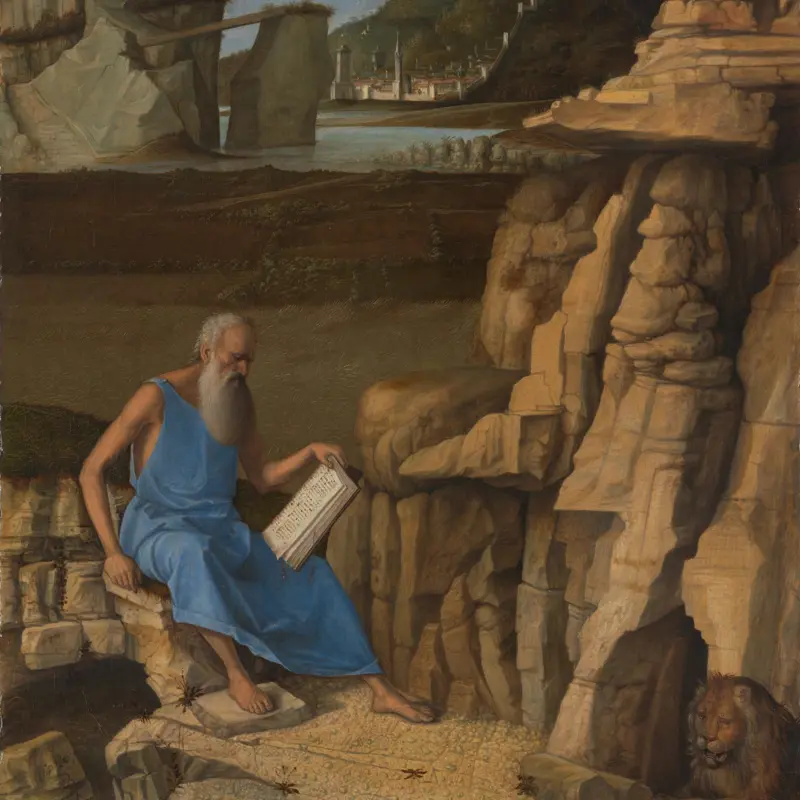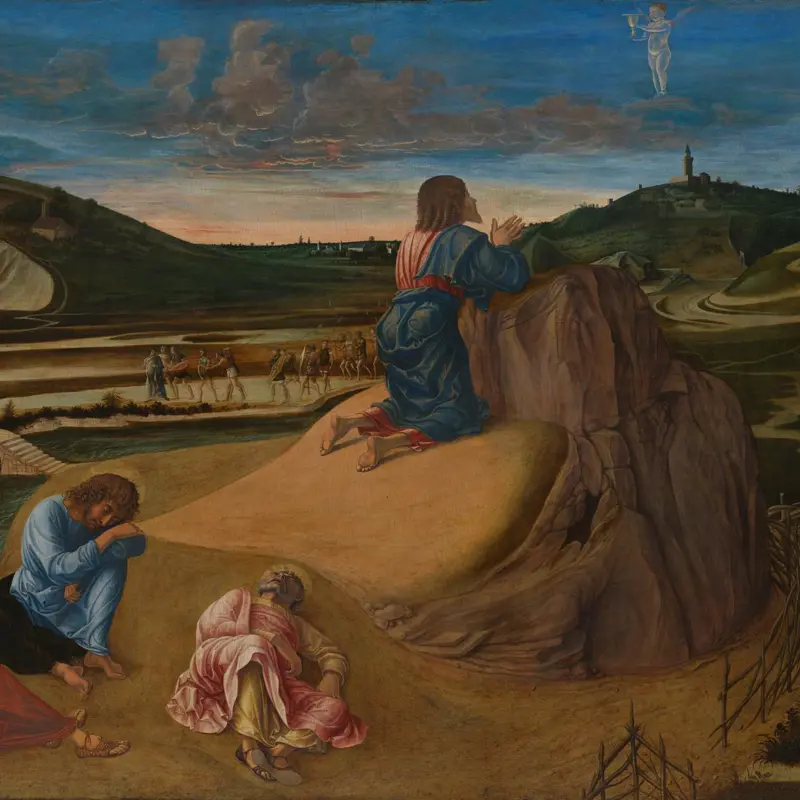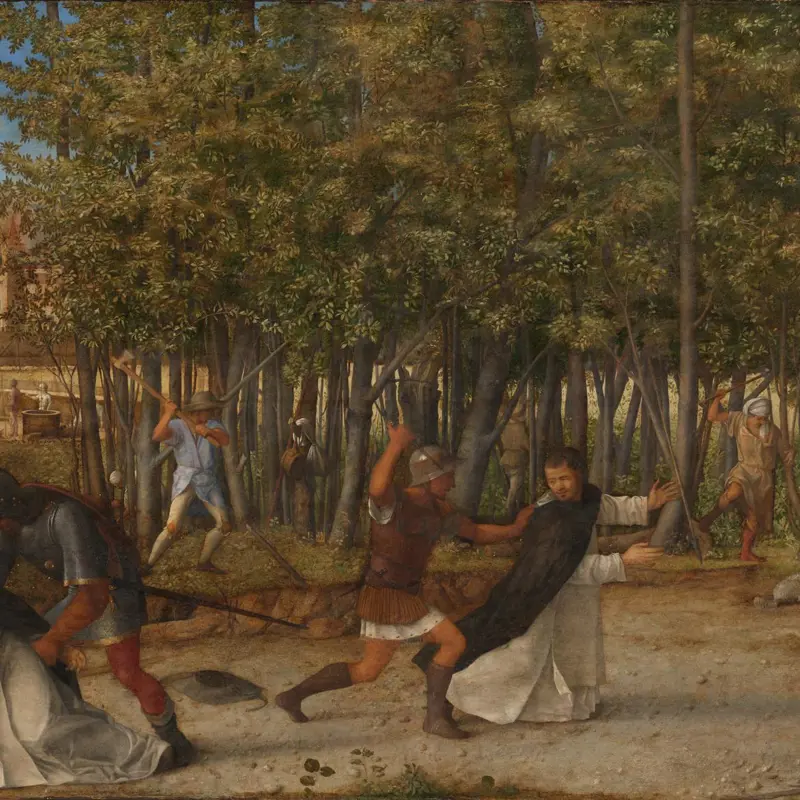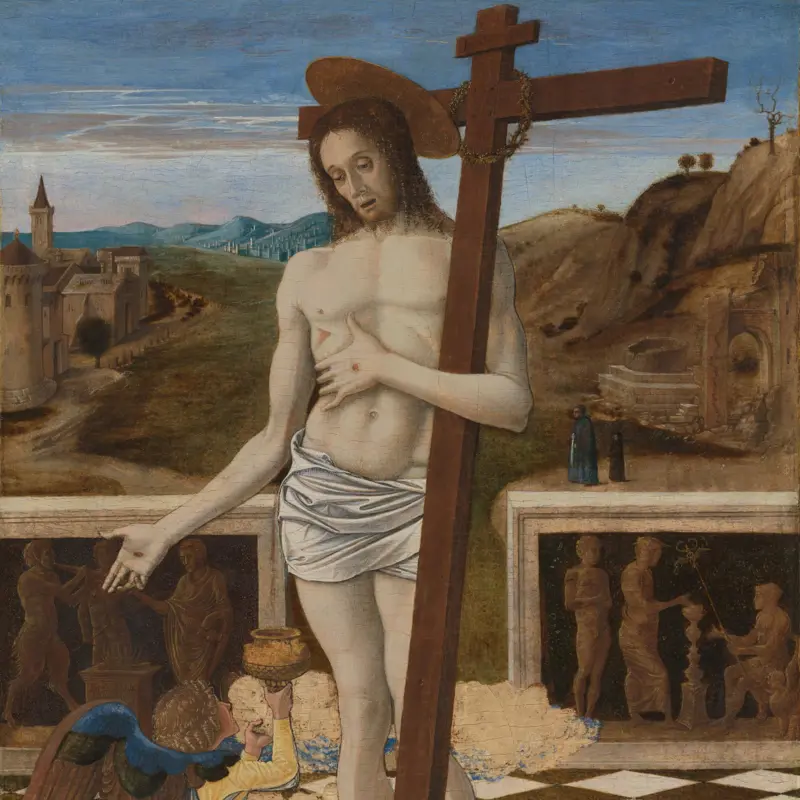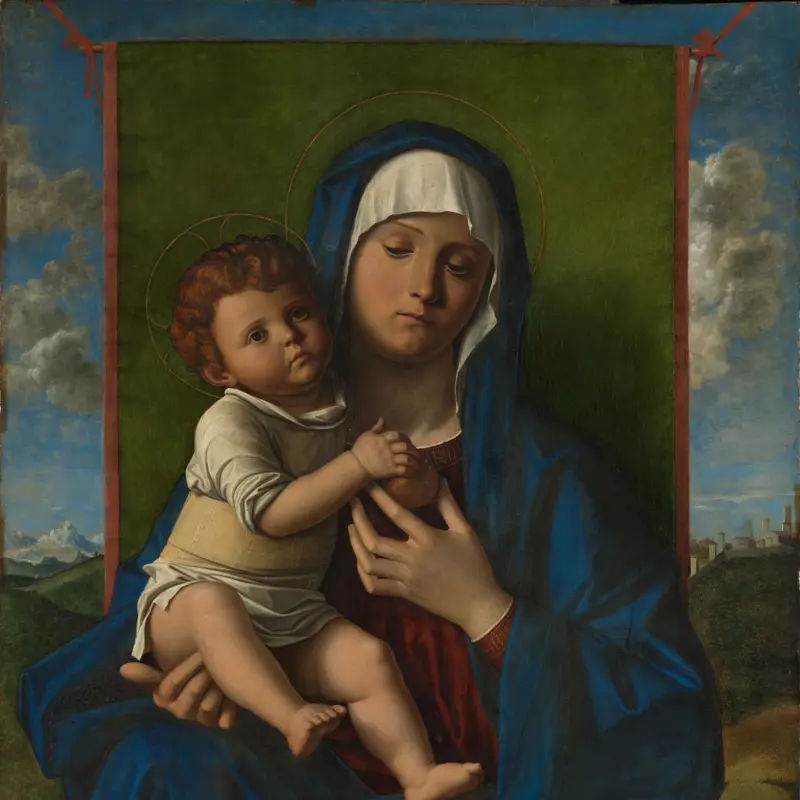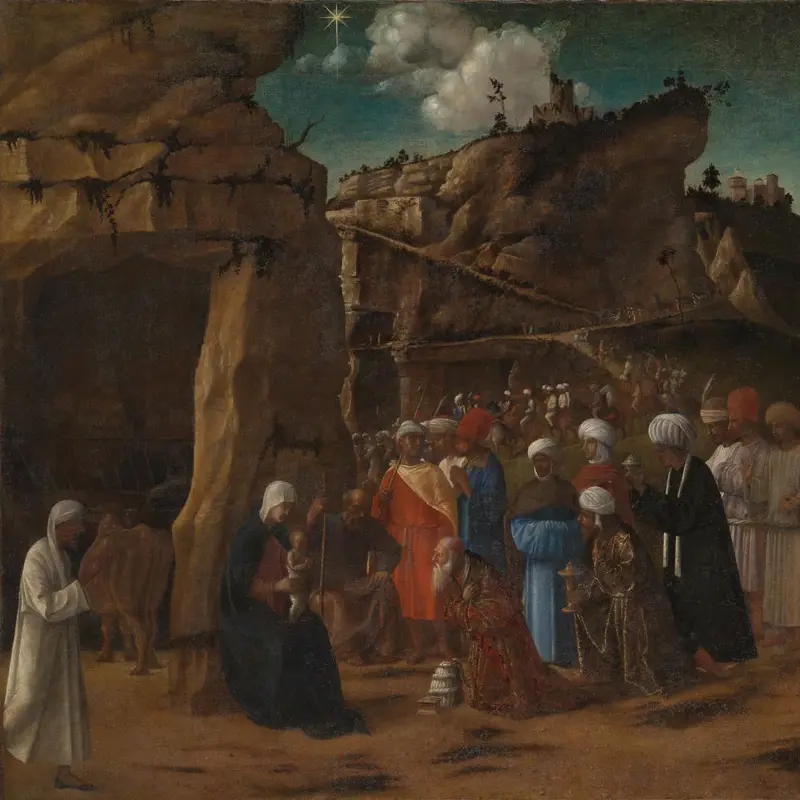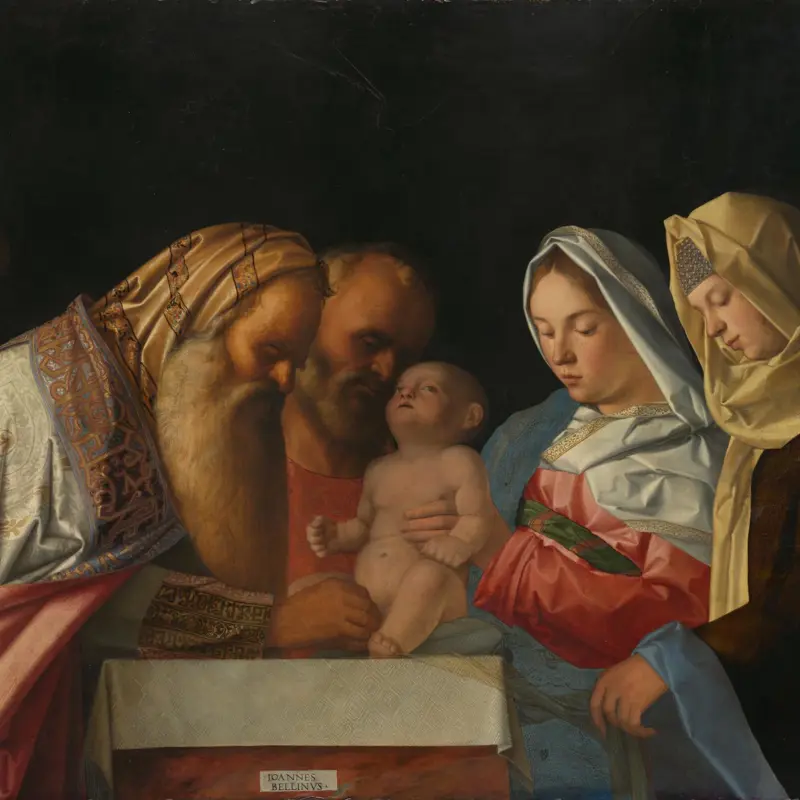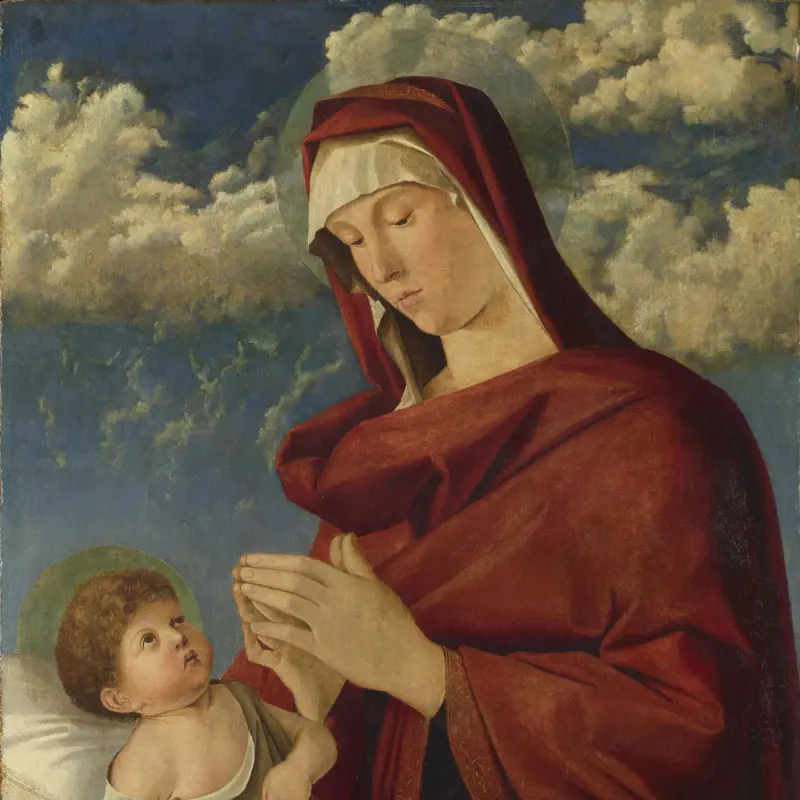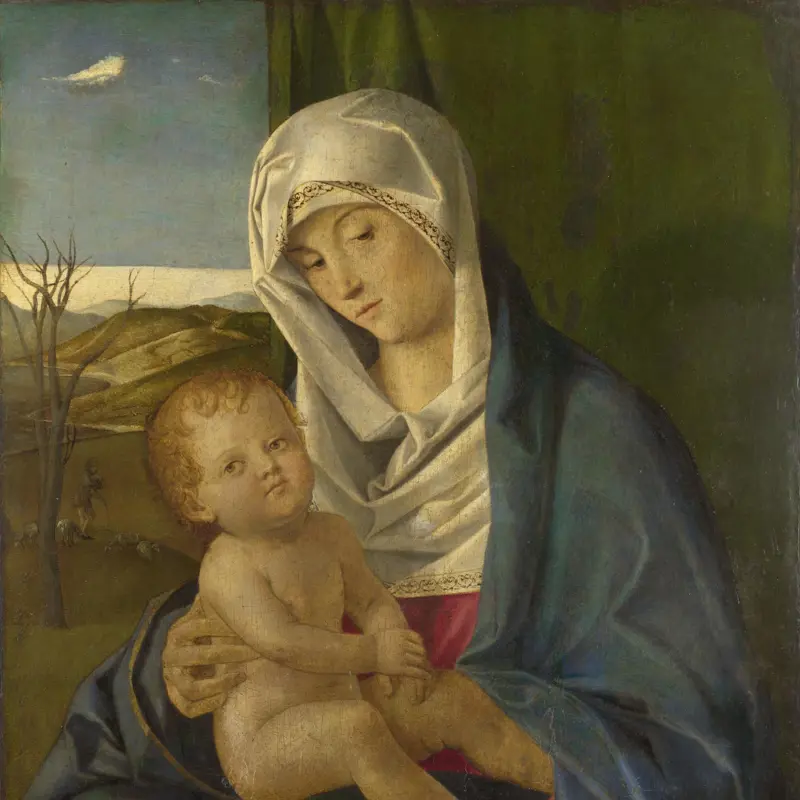Giovanni Bellini, 'Doge Leonardo Loredan', about 1501-2
About the work
Overview
Leonardo Loredan knows that he is being looked at, but he does not return our gaze. He is the doge, the ruler of the Venetian Republic; elected in 1501, he ruled until his death in 1521.
He wears white silk damask robes woven with gold and silver metal thread, clothing reserved for the most splendid occasions, including the feasts of Candlemas and the Annunciation. The armless, half-length representation recalls classical marble busts of emperors. Often placed on plinths – recalled here by the parapet – these were adopted in the Renaissance period for sculpted portraits of the powerful and wealthy.
Bellini no doubt wanted to make this visual connection, but here he shows how he can surpass sculptural portraits through his mastery of oil paint. The subtle blending of colour in this slow-drying medium allowed him to create convincing tonal transitions when painting flesh. Oil paint also lends itself to slightly blurred contours; Loredan’s expression seems changeable, making him appear lifelike and immediate as well as distant and imposing.
Key facts
Details
- Full title
- Doge Leonardo Loredan
- Artist
- Giovanni Bellini
- Artist dates
- about 1435 - 1516
- Date made
- about 1501-2
- Medium and support
- oil on wood
- Dimensions
- 61.4 × 44.5 cm
- Inscription summary
- Signed
- Acquisition credit
- Bought, 1844
- Inventory number
- NG189
- Location
- Room 63
- Collection
- Main Collection
- Previous owners
- Frame
- 16th-century Venetian Frame
Provenance
Additional information
Text extracted from the ‘Provenance’ section of the catalogue entry in Martin Davies, ‘National Gallery Catalogues: The Earlier Italian Schools’, London 1986; for further information, see the full catalogue entry.
Exhibition history
-
2008Renaissance Faces: Van Eyck to TitianThe National Gallery (London)15 October 2008 - 18 January 2009
-
2018Mantegna and BelliniThe National Gallery (London)1 October 2018 - 27 January 2019
-
2018Mantegna and Bellini: Masters of the RenaissanceGemäldegalerie (Berlin)1 March 2019 - 30 June 2019
-
2021The Director's Choice: Lizards, Fancy Feathered Hats and TrickeryThe National Gallery (London)5 May 2021 - 9999
Bibliography
-
1568G. Vasari, Vite de' più eccellenti architetti, pittori et scultori, 2nd edn, Florence 1568
-
1822J. Rutter, A Description of Fonthill Abbey and Demesne, in the County of Wilts: Including A List of Its Paintings, Cabinets, and Other Curiosies, 2nd edn, Shaftesbury 1822
-
1822J. Christie, Magnificent Effects at Fonthill Abbey, London, 8 October 1822 - 17 October 1822
-
1838G.F. Waagen, Works of Art and Artists in England, trans. H. Lloyd, vol. 2, London 1838
-
1845G. Foggo, A Catalogue of the Pictures in the National Gallery with Critical Notes, London 1845
-
1847R.N. Wornum, Descriptive and Historical Catalogue of the Pictures in the National Gallery, London 1847
-
1854G.F. Waagen, Treasures of Art in Great Britain: Being and Account of the Chief Collections of Paintings, Drawings, Sculptures, Illuminated Mss. […], vol. 2, trans. E. Eastlake, London 1854
-
1854R.N. Wornum and C.L. Eastlake, Descriptive and Historical Catalogue of the Pictures in the National Gallery, with Biographical Notices of the Painters, London 1854
-
1867A.A. Lavice, Revue des musées d'Angleterre, Paris 1867
-
1871J.A. Crowe and G.B. Cavalcaselle, A History of Painting in North Italy: Venice, Padua, Vicenza, Verona, Ferrara, Milan, Friuli, Brescia, from the Fourteenth to the Sixteenth Century, 2 vols, London 1871
-
1878H. Blackburn, Illustrated Catalogue to the National Gallery: Foreign Schools, London 1878
-
1878G. Vasari, Le vite de'più eccellenti pittori, scultori ed architettori: Con nuove annotazioni e commenti di Gaetano Milanesi, ed. G. Milanesi, 8 vols, Florence 1878
-
1887M.-F. Reiset, Une visite à la Galerie nationale de Londres, 2nd revised edn, Rapilly 1887
-
1888E.T. Cook, A Popular Handbook to the National Gallery Including, by Special Permission, Notes Collected from the Works of Mr. Ruskin, London 1888
-
1900R. Fry, Giovanni Bellini, 2nd edn, London 1900
-
1901A. Venturi, Storia dell'arte italiana, 11 vols, Milan 1901
-
1927G.F. Hill, A Corpus of Italian Medals of the Renaissance Before Cellini, 2 vols, London 1927
-
1937A. de Mosto, I Dogi di Venezia, Venice 1937
-
1946H. Gambier, The Doges of Venice: A Small History of the Republic of Venice, Venice 1946
-
1951Davies, Martin, National Gallery Catalogues: The Earlier Italian Schools, London 1951
-
1957B. Alexander (ed.), Life at Fonthill, 1807-1822, with Interludes in Paris and London from the Correspondence of William Beckford, London 1957
-
1961M. Davies, The Earlier Italian Schools, 2nd edn, London 1961
-
1962F. Heinemann, Giovanni Bellini e i Belliniani, 3 vols, Venice 1962
-
1962S. Sinding-Larsen, 'Titian's Madonna di Ca'Pesaro and Its Historical Significance', Acta ad archaeologiam et artium historiam pertinentia, I, 1962, pp. 161-9
-
1972N. Huse, Studien zu Giovanni Bellini, Berlin 1972
-
1978D. Robertson, Sir Charles Eastlake and the Victorian Art World, Princeton 1978
-
1982G. Romanelli, 'Ritrattistica dogale: Ombre, immagini e volti', in G. Benzoni (ed.), I Dogi, Milan 1982
-
1984F. Russell, 'The Cawdor Collection', Country Life, 1984, pp. 1746-80
-
1985J. Meyer zur Capellen, Gentile Bellini, Stuttgart 1985
-
1986Davies, Martin, National Gallery Catalogues: The Earlier Italian Schools, revised edn, London 1986
-
1987D. Ferrara, Il doge Leonardo Loredan: Politica culturale e commissioni artistiche, Phd Thesis, Rome University 1987
-
1988S.M. Newton, The Dress of the Venetians, 1495-1525, Aldershot 1988
-
1989R. Goffen, Giovanni Bellini, New Haven 1989
-
1990L. Campbell, Renaissance Portraits: European Portrait-Painting in the 14th, 15th and 16th Centuries, New Haven 1990
-
1990J. Vinson (ed.), International Dictionary of Art and Artists, Chicago 1990
-
1990R. Goffen, 'Piety and Politics in the Art of Giovanni Bellini', in C.M. Rosenberg (ed.), Art and Politics in Late Medieval and Early Renaissance Italy, 1250-1500, London 1990, pp. 207-26
-
1991J. Dunkerton et al., Giotto to Dürer: Early Renaissance Painting in the National Gallery, New Haven 1991
-
1991D. Ferrara, 'Il Doge Leonardo Loredan e una veduta di Venezia', Osservatorio delle arti, VI, 1991, pp. 24-33
-
1991D. Ferrara, 'Il ritratto del doge Leonardo Loredan: Strategie dell'abito tra politica e religione', Venezia cinquecento, I/2, 1991, pp. 89-108
-
1992A. Tempestini, Giovanni Bellini. Catalogo completo dei dipinti, Florence 1992
-
1992S. Simi, 'Considerazioni attorno a un busto di Leonardo Loredan', Antichità viva, XXXI, 1992, pp. 25-36
-
1994E. Langmuir, The National Gallery Companion Guide, London 1994
-
1994F. Russell, 'Early Italian Pictures and Some English Collectors (documents for the History of Collecting)', The Burlington Magazine, CXXXVI, 1994, pp. 85-90
-
1995P. Humfrey, Painting in Renaissance Venice, New Haven 1995
-
1996R.H. Smith, Concors Unanimis and Sixteenth-Century Images of the Doge of Venice, Ann Arbor 1996
-
1997P.F. Brown, The Renaissance in Venice: A World Apart, London 1997
-
1997N. Penny, Frames, London 1997
-
1997G.M. Fara, 'Sul secondo soggiorno di Albrecht Dürer in Italia e sulla sua amicizia con Giovanni Bellini', Prospettiva, 1997, pp. 91-6
-
1997D. Pincus, 'Mark Gets the Message: Mantegna and the Praedestinatio in Fifteenth-Century Venice', Artibus et historiae, XVIII/35, 1997, pp. 135-46
-
1999B. Aikema and B.L. Brown (eds), Renaissance Venice and the North: Crosscurrents in the Time of Bellini, Dürer and Titian, (exh. cat. Palazzo Grassi, 5 September 1999 - 9 January 2000), Milano 1999
-
2000A. Tempestini, Giovanni Bellini, Maestri (Electa editrice) 14, Milan 2000
-
2001
C. Baker and T. Henry, The National Gallery: Complete Illustrated Catalogue, London 2001
-
2003L.F. Gersi, Il Rinascimento veneziano di Giovanni Bellini, Venice 2003
-
2004M. Bailey (ed.), The Folio Society Book of the 100 Greatest Paintings, London 2004
-
2004J. Dunkerton, 'Bellini's Technique', in P. Humfrey (ed.), The Cambridge Companion to Giovanni Bellini, Cambridge 2004, pp. 195ff
-
2008L. Campbell et al., Renaissance Faces: Van Dyck to Titian (exh. cat., The National Gallery, London), London 2008
-
2008L. Syson et al., Renaissance Faces: Van Eyck to Titian (exh. cat. The National Gallery, 15 October 2008 - 16 January 2009), London 2008
About this record
If you know more about this work or have spotted an error, please contact us. Please note that exhibition histories are listed from 2009 onwards. Bibliographies may not be complete; more comprehensive information is available in the National Gallery Library.

